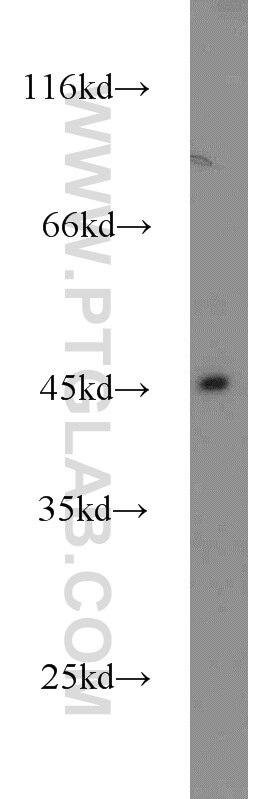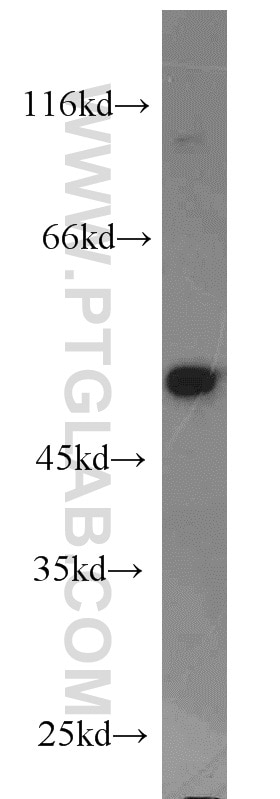Dysbindin Polyklonaler Antikörper
Dysbindin Polyklonal Antikörper für WB, IHC, ELISA
Wirt / Isotyp
Kaninchen / IgG
Getestete Reaktivität
human, Maus, Ratte
Anwendung
WB, IF, IHC, ELISA
Konjugation
Unkonjugiert
Kat-Nr. : 11132-1-AP
Synonyme
Galerie der Validierungsdaten
Geprüfte Anwendungen
| Erfolgreiche Detektion in WB | Maushirngewebe, humanes Hodengewebe, Maushodengewebe |
| Erfolgreiche Detektion in IHC | Maushirngewebe Hinweis: Antigendemaskierung mit TE-Puffer pH 9,0 empfohlen. (*) Wahlweise kann die Antigendemaskierung auch mit Citratpuffer pH 6,0 erfolgen. |
Empfohlene Verdünnung
| Anwendung | Verdünnung |
|---|---|
| Western Blot (WB) | WB : 1:500-1:2000 |
| Immunhistochemie (IHC) | IHC : 1:50-1:500 |
| It is recommended that this reagent should be titrated in each testing system to obtain optimal results. | |
| Sample-dependent, check data in validation data gallery | |
Veröffentlichte Anwendungen
| WB | See 5 publications below |
| IF | See 1 publications below |
Produktinformation
11132-1-AP bindet in WB, IF, IHC, ELISA Dysbindin und zeigt Reaktivität mit human, Maus, Ratten
| Getestete Reaktivität | human, Maus, Ratte |
| In Publikationen genannte Reaktivität | human, Maus |
| Wirt / Isotyp | Kaninchen / IgG |
| Klonalität | Polyklonal |
| Typ | Antikörper |
| Immunogen | Dysbindin fusion protein Ag1613 |
| Vollständiger Name | dystrobrevin binding protein 1 |
| Berechnetes Molekulargewicht | 351 aa, 39 kDa |
| Beobachtetes Molekulargewicht | 48 kDa, 36 kDa |
| GenBank-Zugangsnummer | BC011912 |
| Gene symbol | Dysbindin |
| Gene ID (NCBI) | 84062 |
| Konjugation | Unkonjugiert |
| Form | Liquid |
| Reinigungsmethode | Antigen-Affinitätsreinigung |
| Lagerungspuffer | PBS mit 0.02% Natriumazid und 50% Glycerin pH 7.3. |
| Lagerungsbedingungen | Bei -20°C lagern. Nach dem Versand ein Jahr lang stabil Aliquotieren ist bei -20oC Lagerung nicht notwendig. 20ul Größen enthalten 0,1% BSA. |
Hintergrundinformationen
Dysbindin, encoded by DTNBP1 (dystrobrevin binding protein 1), is a synaptic protein which is expressed in diverse neuronal populations throughout the brain. Genetic variation in DTNBP1 is associated with schizophrenia. Reduced expression of dysbindin has been reported in the dorsolateral prefrontal cortex (DLPFC) of schizophrenia cases. Several isoforms of dysbindin exist: 48-50 kDa of dysbindin-1A, 35-38 kDa of dysbindin-1B, and 30-32 kDa of dysbindin-1C. This antibody recognizes all of isoforms of dysbindin. (19617633)
Protokolle
| Produktspezifische Protokolle | |
|---|---|
| WB protocol for Dysbindin antibody 11132-1-AP | Protokoll herunterladen |
| IHC protocol for Dysbindin antibody 11132-1-AP | Protokoll herunterladen |
| Standard-Protokolle | |
|---|---|
| Klicken Sie hier, um unsere Standardprotokolle anzuzeigen |
Publikationen
| Species | Application | Title |
|---|---|---|
J Cell Biol BLOC-1 is required for selective membrane protein trafficking from endosomes to primary cilia. | ||
Am J Respir Cell Mol Biol Gene-edited MLE-15 Cells as a Model for the Hermansky Pudlak Syndromes. | ||
Neuropharmacology Mice with dopaminergic neuron-specific deletion of DTNBP-1 gene show blunted nucleus accumbens dopamine release and associated behaviors. | ||
Neuroscience Protein kinase B/Akt1 phosphorylates dysbindin-1A at serine 10 to regulate neuronal development. | ||
Br J Pharmacol Dopaminergic signaling and behavioral alterations by Comt-Dtnbp1 genetic interaction and their clinical relevance | ||
Transl Psychiatry Deletion of Dtnbp1 in mice impairs threat memory consolidation and is associated with enhanced inhibitory drive in the amygdala. |






